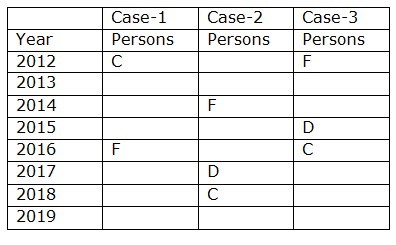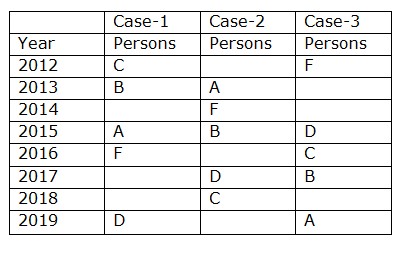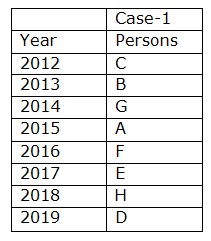Question
Four of the following five are alike in a certain way
as per the given arrangement and thus form a group. Who among the following one does not belong to the group? Study the following information carefully and answer the questions given below. Eight persons A, B, C, D, E, F, G and H completed Army training in eight different years viz. 2012 to 2019, but not necessarily in the same order. D completed the training three years after F. Only three persons completed the training between C and F. C doesn’t complete on an odd numbered year. The number of persons completed before D is one more than the number of persons completed after B. Only one person completed the training between B and A. The difference between the years in which G and E completed is three years. Both H and E completed the training in consecutive years.Solution
We have, D completed the training three years after F. Only three persons completed the training between C and F. C doesn’t complete on an odd numbered year. From the above condition, there are three possibilities  Again we have, The number of persons completed before D is one more than the number of persons completed after B. Only one person completed the training between B and A.
Again we have, The number of persons completed before D is one more than the number of persons completed after B. Only one person completed the training between B and A.  Again we have, The difference between the years in which G and E completed is three years. Both H and E completed the training in consecutive years. So Case2 and 3 get eliminated, hence the final arrangement becomes
Again we have, The difference between the years in which G and E completed is three years. Both H and E completed the training in consecutive years. So Case2 and 3 get eliminated, hence the final arrangement becomes 
Which two organizations partnered to launch the India Skills Accelerator?
Which of the following statements accurately describe the launch of UPI at Galeries Lafayette in Paris?
1. UPI was launched as part of an effort ...
Who is the chairman of the government task force established to boost textile exports?
Which institute will launch its new campus in Delhi with courses for working professionals and entrepreneurs.aiming to tap people who want to pursue man...
What award did Garden Reach Shipbuilders & Engineers Limited (GRSE) receive on the occasion of Durga Puja, presented by the Governor of West Bengal?
What is India's ranking in the 2023 World Press Freedom Index released by Reporters Without Borders (RSF)?
Which of the following is the official mascot of FIFA Women’s World Cup Australia & New Zealand 2023?
- Which state topped the medal tally in the Khelo India Para Games 2025?
Orbital Rail Corridor has been launched in which state of India?
‘World of Advance Virtual Experience (WAVE)’ is an initiative of which Indian public sector bank?
Relevant for Exams:


